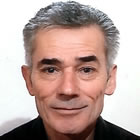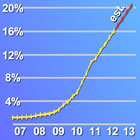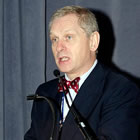 Next week, on September 17-18, 2015, the 4th Advanced International Masterclass on the Transradial Approach will be held in Liverpool, England and, if you already perform or want to start using the wrist approach to diagnostic or interventional procedures, you need to attend. Where else will you be able to spend two-days with the most expert and experienced radial practitioners in the world?
Next week, on September 17-18, 2015, the 4th Advanced International Masterclass on the Transradial Approach will be held in Liverpool, England and, if you already perform or want to start using the wrist approach to diagnostic or interventional procedures, you need to attend. Where else will you be able to spend two-days with the most expert and experienced radial practitioners in the world?
I went to the last two AimRADIAL courses in New York City and Chicago and witnessed something I hadn’t really seen since the early days of angioplasty: a relatively small meeting (i.e. less than 300) attended by the pioneers of the procedure, cardiologists who have the largest experience in the radial approach, talking among themselves and trading their latest findings and techniques with each other, and sharing this information with the newer generation of physicians in attendance.It felt like an actual community!
It was a different vibe from massive meetings like TCT or EuroPCR, more personal and, of course, with a very specific agenda: doing procedures from the wrist. It was heartening (yes, a pun found its way into my sentence) to see so many of the physicians who in little more than a decade have changed the procedure of angioplasty worldwide to increase patient safety, comfort and outcomes.
This year the AimRADIAL Masterclass is being combined with the Transradial Masterclass UK. The course organizers are James Nolan, MBChB MD, Stoke on Trent, Staffordshire, UK and Olivier F Bertrand, MD PhD of Quebec (QC), Canada.

Dr. Ferdinand Kiemeneij
At this year’s meeting, the “father of transradial,” Dr. Ferdinand Kiemeneij, will be attending and heading a panel discussion on “Slender Techniques.” And if you don’t know what that is, it’s just another reason for you to attend!! (Hint: “Slender techniques” consist of cutting edge equipment and techniques that allow extremely narrow catheters to traverse the radial artery and perform procedures with minimal trauma.)
Other internationally-known radialists, to name a few, are Drs. Ian Gilchrist, Jennifer Tremmel, John Coppola, Samir Pancholy, David Kandzari and more from the United States, and Giovanni Amoroso (Netherlands), Ivo Bernat (Czech Republic), Sasko Kedev (Macedonia), Shigeru Saito and Fuminobu Yoshimachi (Japan), and many many more from countries all over the world.
There also will be five live cases, taped demonstrations and a wide spectrum of talks, addressing all aspects of the transradial approach, including a special Endovascular thread for interventions in the leg, kidney, etc.
So…if you’re thinking of attending AimRADIAL 2015, check out the distinguished faculty, and check out the program agenda.
A word on the faculty. Although there are a number of faculty from the U.S., there are more cardiologists from outside the U.S. and that’s a good thing because the radial approach has been used far more extensively OUS than in the States. The U.S. is playing late catch-up.
 When we started the Transradial Access Center on Angioplasty.Org back in 2007, less than 2% of U.S. procedures were performed via the wrist; eight years later the figure is around 20%, a ten-fold increase. During this period there have also been a number of clinical studies and analyses of data, all pointing to the fact that the wrist approach can lead to lower costs, less complications, better 30-day and long-term outcomes and, oh yeah, better patient comfort! Almost every patient who has experienced catheter-based procedures from both the femoral and radial approaches has strongly preferred the radial every time.
When we started the Transradial Access Center on Angioplasty.Org back in 2007, less than 2% of U.S. procedures were performed via the wrist; eight years later the figure is around 20%, a ten-fold increase. During this period there have also been a number of clinical studies and analyses of data, all pointing to the fact that the wrist approach can lead to lower costs, less complications, better 30-day and long-term outcomes and, oh yeah, better patient comfort! Almost every patient who has experienced catheter-based procedures from both the femoral and radial approaches has strongly preferred the radial every time.
And then there’s the hard data. Published in a 2014 issue of the Journal of the American College of Cardiology, a study of 350,000 patients in the UK concluded:
TRA [TransRadial Angioplasty] was independently associated with reduced 30-day mortality, and the magnitude of this effect was related to baseline bleeding risk; those at highest risk of bleeding complications gained the greatest benefit from adoption of TRA during PCI.
Most importantly, the European Society of Cardiology just issued new guidelines for the treatment of patients with acute coronary syndromes (ACS). These are patients in pre-heart attack or heart attack situations, and the recommendation is now that the radial approach is the preferred approach (over the femoral) because it has been demonstrated to reduce mortality! Read our article, “European Guidelines Say “Radial First“, about this issue.

Dr. Olivier Bertrand
Back to the AimRADIAL course, co-organizer and radial pioneer, Olivier F. Bertrand, MD, PhD, told Angioplasty.Org that “Besides usual themes, special emphasis will be placed this year on 1) peripheral intervention and radial approach, 2) use of dedicated universal catheters versus standard catheters, 3) cost benefits for radial approach in the USA and around the world, including new practice such as same-day discharge, 4) how to use new anticoagulants and new antiplatelets in the lab, 5) radial artery injury and occlusion: prevention and treatment.”
This last point is interesting. Because the radial approach is positioned as a safer alternative to femoral, most radialists are very sensitive to the subject of complications. And, like any medical procedure, there are complications to the transradial approach, but they are small in percentage. However, they do exist and there are several lectures on the program about possible complications, how to avoid them, and what to do about them when they occur.
Finally, the course is not just for doctors. One of the course faculty is Bernadette Speiser, RN. There’s no question that a radial program in a hospital can only be successful when the entire cath lab team is on-board. So emphasis on the nursing, tech and ancillary staff is central to the procedure.
More information about AimRADIAL can be found on the course web site at AIMRADIAL.org. Registration for the course can be found here.
Update on September 11, 2015: If you can’t make the AimRADIAL meeting next week, follow my live tweets of the meeting, starting on Thursday morning, September 17. I will also take questions. Use the hashtag #AIMRADIAL.



